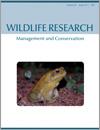Context. Accurate surveying and monitoring of biodiversity provides essential baseline data for developing and implementing effective environmental management strategies. Land managers in arid zones face the challenge of managing vast, remote landscapes that support numerous cryptic species that are difficult to detect and monitor. Although researchers and land managers are using an increasingly wider variety of monitoring techniques to detect and monitor species, little is known of the relative effectiveness and comparative costs of these techniques.
Aims. The present study simultaneously assessed the efficacy of three popular monitoring techniques utilised in the spinifex sand plains of arid Australia, namely, live trapping, sign surveys and passive infrared (PIR)-camera trapping.
Methods. We explored variations in capture rates and species richness for each technique and compared initial and on-going costs of the techniques over time.
Key results. Sign surveys detected the greatest number of species and groups overall. Detectability of small mammals and reptiles, as a target group, was greater using PIR cameras, although the probability of detection by each technique varied among specific species. PIR cameras were initially the most expensive technique; however, the low ongoing costs of maintaining cameras in the field meant that they became the most cost effective after eight survey periods.
Conclusions. Each of the techniques tested here showed biases towards the detection of specific groups or species in the spinifex sand-plain habitat of Australia. Regardless, PIR cameras performed better at detecting the greatest diversity of target species and financially over time.
Implications. To accurately survey species across vast areas and climate variations, studies often extend over long time periods. Many long-term studies would be likely to benefit financially from the increased deployment of PIR cameras alongside or in place of live trapping surveys, with little impact on the ability to monitor the presence of most species in the region.





